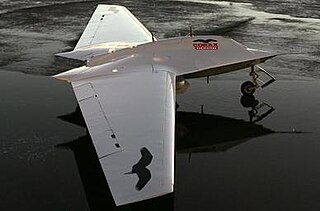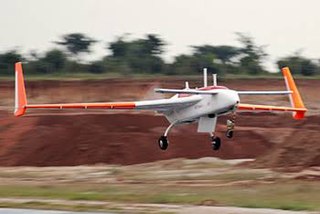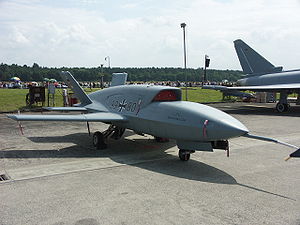
The RQ-3 DarkStar is an unmanned aerial vehicle (UAV). Its first flight was on March 29, 1996. The Department of Defense terminated DarkStar in January 1999, after determining the UAV was not aerodynamically stable and was not meeting cost and performance objectives.

The Boeing X-45 unmanned combat air vehicle is a concept demonstrator for a next generation of completely autonomous military aircraft, developed by Boeing's Phantom Works. Manufactured by Boeing Integrated Defense Systems, the X-45 was a part of DARPA's J-UCAS project.

The Dassault nEUROn is an experimental unmanned combat aerial vehicle (UCAV) being developed with international cooperation, led by the French company Dassault Aviation. Countries involved in this project include France, Greece, Italy, Spain, Sweden and Switzerland. The design goal is to create a stealthy, autonomous UAV that can function in medium-to-high threat combat zones.

The Corax, also known as Raven, is a prototype unmanned aerial vehicle (UAV) for the British Armed Forces being developed by BAE Systems Military Air & Information.

The Northrop Grumman X-47B is a demonstration unmanned combat aerial vehicle (UCAV) designed for aircraft carrier-based operations. Developed by the American defense technology company Northrop Grumman, the X-47 project began as part of DARPA's J-UCAS program, and subsequently became part of the United States Navy's Unmanned Combat Air System Demonstration (UCAS-D) program. The X-47B is a tailless jet-powered blended-wing-body aircraft capable of semi-autonomous operation and aerial refueling.
Swedish Highly Advanced Research Configuration (SHARC) is an experimental stealth unmanned aerial vehicle (UAV) built by Saab AB. Saab also plays a role in the creation of UAVs such as the stealth UAV Filur and stealth UCAV Dassault nEUROn.
The Dassault LOGIDUC – sometimes spelled Logiduc in French and LogiDuc in English – was an autonomous industrial program launched in 1999 by the French aircraft manufacturer Dassault Aviation in view to develop its UAV design capacities. This French programme eventually led to the creation of the Dassault-Sagem Tactical UAV company and to the European "combat drone" project nEUROn.

The BAE Systems Taranis is a British demonstrator programme for unmanned combat aerial vehicle (UCAV) technology, under development primarily by the defence contractor BAE Systems Military Air & Information. The aircraft, which is named after the Celtic god of thunder Taranis, first flew in 2013. An unmanned warplane, the Taranis is designed to fly intercontinental missions, and would carry a variety of weapons, enabling it to attack both aerial and ground targets. It uses stealth technology, giving it a low radar profile, and is controllable via satellite link from anywhere on Earth.

The BAE Systems HERTI is an unmanned aerial vehicle (UAV) developed by the British company BAE Systems. HERTI stands for "High Endurance Rapid Technology Insertion" and was developed in Warton, United Kingdom. The HERTI airframe is based on the J-6 Fregata motor glider designed by Jaroslaw Janowski of J&AS Aero Design in Poland. Its first flight was in December 2004 at the Australian Woomera test range where much of the test flight programme has been undertaken. HERTI was also the first UAV to fly in the UK with the flight being certified by the Civil Aviation Authority.

The BAE Systems Mantis Unmanned Autonomous System Advanced Concept Technology Demonstrator is a British demonstrator programme for Unmanned Combat Air Vehicle (UCAV) technology. The Mantis is a twin-engine, turboprop-powered UCAV with a wingspan of approximately 22 m, broadly comparable to the MQ-9 Reaper. Other partners involved in Phase 1 of the Mantis programme include the Ministry of Defence, Rolls-Royce, QinetiQ, GE Aviation, L-3 Wescam, Meggitt and Lola.

The DRDO Rustom is a medium-altitude long-endurance unmanned air vehicle (UAV) being developed by Defence Research and Development Organisation for the three services, Indian Army, Indian Navy and the Indian Air Force of the Indian Armed Forces. Rustom is derived from the NAL's LCRA developed by a team under the leadership of late Prof Rustom Damania in the 1980s. The UAV will have structural changes and a new engine.

The Alenia Aeronautica Sky-X is a self-financed unmanned aerial vehicle (UAV) for demonstration and research purpose; on May 29, 2005, it became the first European-designed UAV in the over 1000 kg category to fly with success.

The Boeing Phantom Ray is an American demonstration stealth unmanned combat air vehicle (UCAV) developed by Boeing using company funds. The autonomous Phantom Ray is a flying wing around the size of a conventional fighter jet, and first flew in April 2011. It will conduct a program of test flights involving surveillance, ground attack and autonomous aerial refueling missions. The developers say it can carry 4,500 pounds of payload.

Ghatak is an autonomous jet powered stealthy unmanned combat air vehicle (UCAV), being developed by Aeronautical Development Establishment (ADE) of the Defence Research and Development Organisation (DRDO) for the Indian Air Force. The design work on the UCAV is to be carried out by Aeronautical Development Agency (ADA). Autonomous Unmanned Research Aircraft (AURA) was a tentative name for the UCAV. Details of the project are classified.

The EADS Talarion is a twinjet Medium-altitude long-endurance unmanned aerial vehicle, designed by EADS, to meet future European military needs for aerial reconnaissance, military intelligence, and aerial surveillance. EADS has run a preliminary design review, and is awaiting orders. The source of the name is the Talaria—the winged sandals of the Greek Messenger god Hermes.
Airbus Defense and Space is the division of Airbus SE responsible for the development and manufacturing of the corporation's defense and space products, while also providing related services. The division was formed in January 2014 during the corporate restructuring of European Aeronautic Defense and Space (EADS), and comprises the former Airbus Military, Astrium, and Cassidian divisions. It is the world's second-largest space company after Boeing and one of the top ten defense companies in the world.

The AVIC Dark Sword is a stealthy supersonic unmanned combat aerial vehicle from the People's Republic of China. It is being developed by the Aviation Industry Corporation of China's Shenyang Aircraft Design Institute for the air superiority or deep strike roles. Use as an autonomous wingman for manned aircraft may also be a goal.

The Airbus Sagitta from Airbus Defence and Space is a jet powered UAV research demonstrator, developed in cooperation with German research institutes as part of the Open Innovation initiative.
The Sukhoi S-70 Okhotnik-B, also referred to as Hunter-B, is a Russian stealth heavy unmanned combat aerial vehicle (UCAV) being developed by Sukhoi and Russian Aircraft Corporation MiG as a sixth-generation aircraft project. The drone is based on the earlier Mikoyan Skat, designed by MiG, and encompassing some technologies of the fifth-generation Sukhoi Su-57 fighter jet. In the future, it is planned to act under the control of pilots of Su-57 jets, similarly to the USAF Skyborg programme.
















